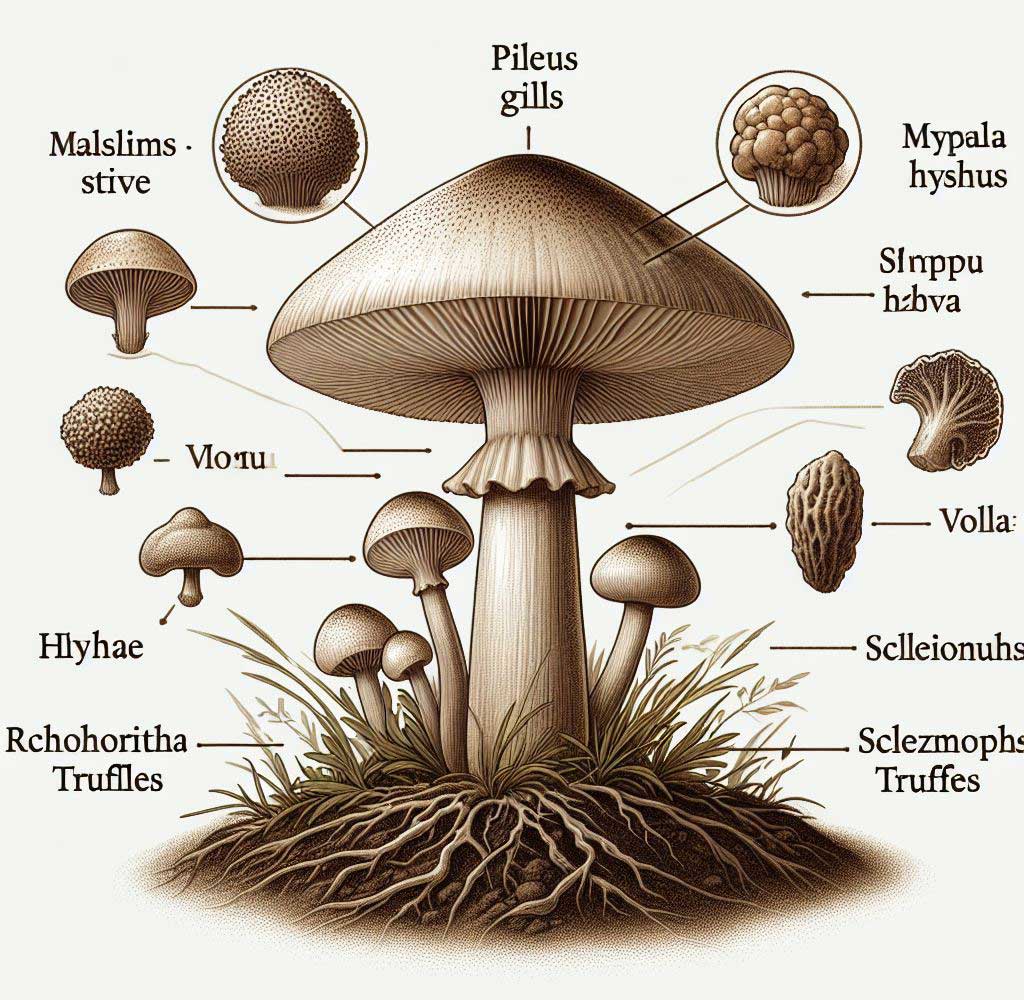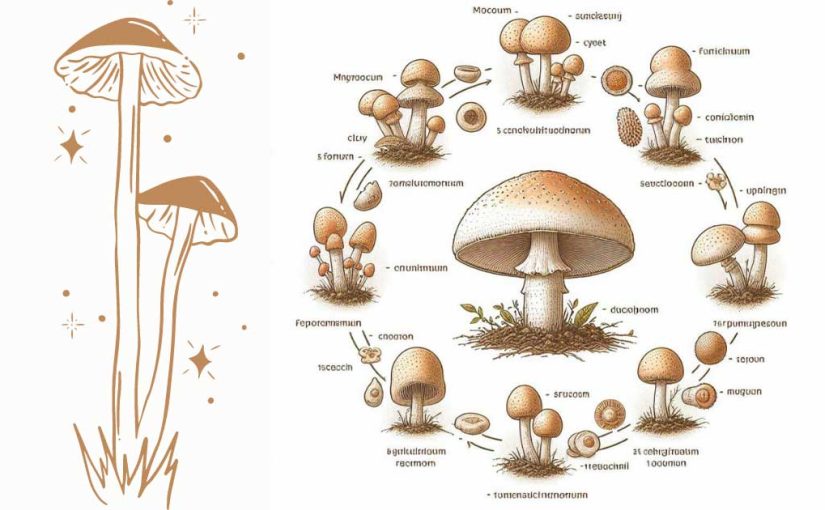Mushrooms are fascinating organisms that belong to the kingdom of Fungi. They are neither plants nor animals but have their own unique characteristics and roles in nature. Mushrooms are also a source of food, medicine, and inspiration for many people worldwide.
But what exactly are mushrooms? How do they grow and reproduce? What are the different parts of a mushroom, and what do they do? In this blog post, we will answer these questions and more as we explore the structure and life cycle of a mushroom.
You Can Read This Related Post: What is The Introduction of Spawn Mushrooms?
The Structure of a Mushroom
The mushroom we see above the ground is only a tiny part of the organism. The fruiting body or basidiocarp is the name given to the reproductive part of the fungus. The fruiting body is composed of the following parts:

Pileus:
This is the cap or the roof of the mushroom. Depending on the species, it can have various shapes, colors, and textures. The pileus protects the gills or the lamellae, which are located on its underside.
Gills or Lamellae:
These thin, vertical plates radiate from the pileus’s center. They are the site of spore production and dispersal. Spores are the microscopic seeds of the fungus, which can germinate and form new mushrooms under favorable conditions.
Stipe or Stalk:
This is the stem-like structure that supports the pileus. Depending on the species, it can be long or short, thick or thin, or hollow or solid. The stipe may also have a ring or an annulus around it, a remnant of the veil covering the young mushroom.
Volva or Cup:
This is the base of the stipe, which may have a cup-like shape. Also a remnant of the veil, a thin membrane enclosing the developing mushroom. The presence or absence of a volva can help identify the mushroom species.
The fruiting body is the visible part of the mushroom, but there is much more below the surface. The main body of the fungus is called the mycelium, which is a network of thread-like filaments called hyphae.
The hyphae grow through the substrate, which is the material that the fungus feeds on. The substrate can be soil, wood, dung, or any organic matter. The hyphae release enzymes that break down the substrate into smaller molecules. The fungus then absorbs and uses them for growth and energy.
The mycelium is often unseen, but can sometimes create visible things like sclerotia, rhizomorphs, or truffles. These are different ways that the fungus stores nutrients, survives harsh conditions, or disperses spores.
The Life Cycle of a Mushroom
The life cycle of a mushroom is a complex process that involves four main stages: spore, germ, hyphae, and mature mycelium. Here is a brief overview of each stage:

Spore Stage:
This is the beginning and the end of the mushroom’s life. A grown mushroom releases many spores that can travel far and reach new places in the air or water. The spores are haploid, which means they have only one set of chromosomes. The spores can remain dormant for a long time until they find a suitable environment to germinate.
Germ Stage:
This is when the spore germinates and forms a germ tube, which is the first outgrowth of the spore. The germ tube grows and branches out, forming more hyphae. The hyphae can fuse with other compatible hyphae, forming a dikaryotic mycelium.
It means each mycelium cell has two nuclei, one from each parent hypha. The dikaryotic mycelium is the stage that produces the fruiting body.
Hyphae Stage:
This is when the mycelium grows and colonizes the substrate, consuming and decomposing it. The mycelium can create various structures like sclerotia, rhizomorphs, or truffles, based on the species and environment. The mycelium can sense changes in the environment such as temperature, humidity, light, or nutrients. It responds to these changes by triggering the growth of the fruiting body.
Mature Mycelium Stage:
This is when the mycelium produces the fruiting body, which is the mushroom that we see. The fruiting body is composed of densely packed hyphae, which differentiate into different tissues and organs, such as the pileus, the gills, the stipe, the volva, etc.
The fruiting body is the reproductive part of the fungus, and its main function is to produce and disperse spores. The spores are formed on specialized basidia cells located on the gills or the lamellae.
The basidia undergo meiosis, which is a type of cell division that reduces the number of chromosomes by half. Four haploid spores result from this process, and they are released from the basidia and carried by the wind or water to new locations. The cycle then repeats itself.
Mushroom life cycle varies based on species and environment. Some mushrooms can grow and reproduce rapidly, while others can take years or even decades to complete their life cycle.
Frequently Asked Questions
1. What Is A Mushroom’s Growth Process?
A mushroom grows from spores, then develops mycelium, and finally forms a visible fruiting body, which is the mushroom.
2. How Long Does A Mushroom Life Cycle Take?
Mushrooms can live for a few days to a few months, depending on the type and environment.
3. What Triggers Mushroom Fruiting?
Temperature, humidity, light, and nutrients influence mushroom growth, which prompts the mycelium to produce fruiting bodies.
4. Are Mushrooms plants or Animals?
Mushrooms are not plants or animals. They are part of the fungi kingdom and have a different structure and growth cycle.
Conclusion
Mushrooms are fungi that have a complex structure and life cycle. Mushrooms have two parts: the mycelium, which grows in the soil, and the fruiting body, which produces spores. The life cycle involves four stages: spore germination, mycelial expansion, fruiting body formation, and spore release.
The life cycle has two nuclear fusions. The first one is called plasmogamy. It creates a mycelium with two nuclei.
The second fusion is called karyogamy. It forms a nucleus with two sets of chromosomes. The life cycle also involves meiosis, which produces haploid spores from the diploid nucleus.
